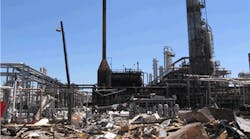I consume a lot of news every day. I’m a news junkie. Short articles, long articles; if it’s news, I’ll read it. And I’m a tough critic.
My hometown “newspaper,” if you want to call it that anymore, annoys me so much I stopped subscribing to it years ago. The management of the newspaper laid off many of the veteran reporters and journalists and hired a group of young, green placeholders (I hesitate to call them writers or reporters). These placeholders never seem to ask the right questions and they never seem to ask enough questions. They accept what they’re fed and move on to the next story.
That’s not journalism.
I’ll tell you what is journalism: A series of articles by a group of reporters, photographers and staffers from the Texas Tribune and the Houston Chronicle. This group of 11 people – an almost unheard of number of people to assign to an article or even a series of articles these days – reported on the state of safety in Texas City 10 years after an explosion at the then-BP Texas City refinery killed 15 workers.
EHS Today covered the tragedy when it occurred. I even wrote an editorial about BP’s response to the deaths of the workers, called “Paris Hilton – 23 days; BP Officials – 0.” In it, I railed against a system that offers no jail time for company officials who know their corporate safety culture is broken and contributing to worker deaths but do nothing about it.
BP fired six (low-level) employees in the wake of the Texas City incident, and in its report, tried to pass off the explosion as a culmination of “behaviors and actions” taken by the employees on site when the incident occurred. When in doubt, blame the dead guy.
The truth of the matter is that BP had a broken safety culture at that facility and management knew it. In the 30 years prior to the 2005 disaster, there were 23 worker deaths at the refinery – three of them in 2004. There have been others since, a fact noted by the Texas Tribune and Houston Chronicle reporters.
They conducted an in-depth investigation into the circumstances surrounding the Texas City explosion; the reasons why the death toll was so high; the impact the explosion had on the families of the victims and the other workers on the site as well as the surrounding community; the citations issued against BP by OSHA (BP ultimately agreed to pay the full penalty of $50.6 million sought by the agency); the changes promised by the oil and gas industry following Texas City; and the current state of safety in the industry.
“Texas City was a huge deal at the time,” Texas Tribune reporter Jim Malewitz told me. “It sparked promises of change from regulators and the industry itself. We found some things had changed, but not to the extent that had been promised or that folks had hoped.”
What Malewitz and the other reporters found is sobering: The death toll at BP's Texas City operation was so high because nonessential personnel were left in harm’s way, a practice that continues today, despite assurances from the industry that non-essential personnel – as well as lunch tents and office trailers – would be moved away from operations. The reporters also noted that at least 58 workers have died at U.S. refineries since March 23, 2005 and federal officials have tracked nearly 350 fires at U.S. refineries in the past eight years – about one every week.
So why place employees in harm’s way? One word, Malewitz admitted: Profit.
“In refining in particular, competition is fierce,” he acknowledged. “There’s not that much space between the top earner and the bottom earner. Anytime you have to shut down [for maintenance, for safety issues, to bring additional workers on site]… There is a tension between profits and safety.”
Malewitz said his takeaway from his interviews and research was that the easiest way to avoid another Texas City-like tragedy is to “not house workers near the most-dangerous places in the operations.”
That said, temporary tents and trailers have returned to the Texas City site, which was purchased by Marathon Petroleum Co. in 2012 for $2.5 billion. These tents and trailers are in the exact location where 15 workers died in 2005.
“A clear message just isn’t getting through,” said Malewitz. According to him, that message should be: “If you don’t have to be here, get lost.”
(Jim Malewitz will be one of the keynote speakers at EHS Today's Safety Leadership Conference in Greenville, S.C., Oct. 27 and 28.)

